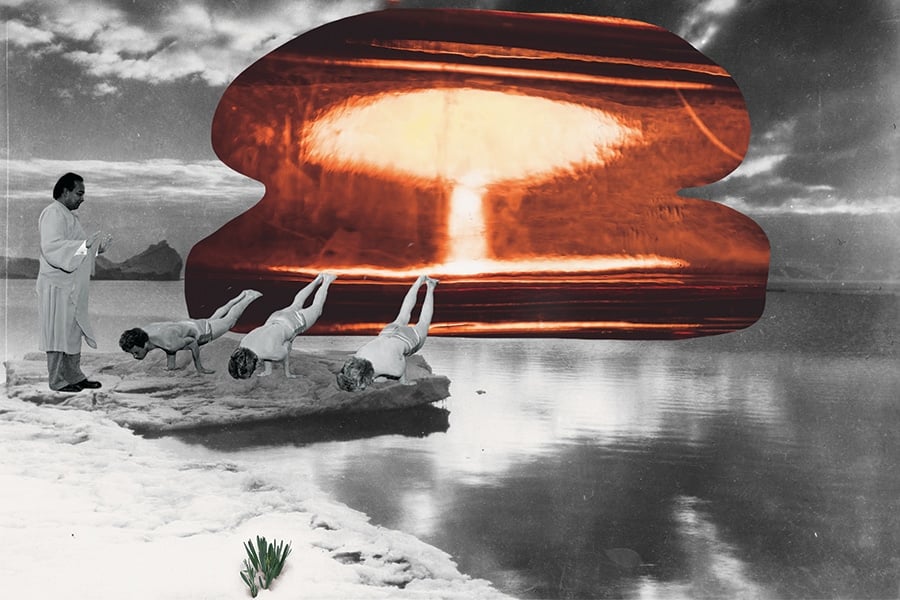“Nature loves courage. You make the commitment and nature will respond to that commitment by removing impossible obstacles. Dream the impossible dream and the world will not grind you under, it will lift you up.” — Terence McKenna
During England’s hottest summer on record, in July of 2018, sustainability educator and strategist Jem Bendell, released an academic paper entitled “Deep Adaptation: A Map For Navigating Climate Tragedy.” In the paper, Bendell draws upon 25 years of his work in sustainability, offering a compelling—and controversial—hypothesis: The time has come for us to “consider the implications of it being too late to avert a global environmental catastrophe in the lifetimes of people alive today.”
The Earth is heating at a rate that is alarming even to the scientists who have been studying climate change for 30 years. We are pushing the natural systems that govern our climate patterns to the brink of failure—right now. As these systems fail, we’ll continue to see a sharp increase in extreme weather events, including heat waves and powerful storm systems. Our ways of living in civilization may be compromised, as clean drinking water evaporates, agricultural systems fail, and our basic needs become increasingly difficult to meet.
This process is already at play in many regions of the Global South, including Syria, where severe drought has led to extreme water shortages and massive crop failure, forcing 1.5 million people to flee from their homelands, seeking refuge in cities where resources were stretched thin, arguably contributing to widespread conflict and a devastating refugee crisis.
But Bendell’s theory isn’t necessarily as depressing as it sounds; in fact, it presents readers with a certain kind of opportunity, he states, “to reassess their work and life in the face of an inevitable near-term social collapse due to climate change.”
In forcing us to accept the imminent socio-environmental shifts that lie ahead in this precarious time in human history, Bendell invites us to instead reflect on the very nature of who we are in relation to our Earth home, to each other, and beyond the oppressive limitations of the capitalist systems in which we’ve found ourselves so comfortably numb. If we give up our attachment to the soon-ending status quo, how do we embrace the overwhelming uncertainty of navigating the end of the world as we know it?
In forcing us to accept the imminent socio-environmental shifts that lie ahead in this precarious time in human history, Bendell invites us to instead reflect on the very nature of who we are in relation to our Earth home, to each other, and beyond the oppressive limitations of the capitalist systems in which we’ve found ourselves so comfortably numb
“The strange joy of climate change,” Bendell reflects, in conversation with author, educator and podcast producer, Amisha Ghadiali, “is the opportunity for us to consider deeper questions like, ‘Why are we alive? How do we wish to live? And, what is important to us?’”
How to Grow Shrooms Bundle
Take Both of Our Courses and Save $90!
Since the release of Bendell’s paper, many of our individual and collective reactions to the climate crisis have mimicked stages of grief: denial of the facts, anger and growing divisiveness towards each other, bargaining to keep our comfortable—albeit oppressive—systems in place, shutting down all emotions, and turning to destructive coping mechanisms. Psychologists have recently qualified ecological grief as a “psychological phenomenon,” triggering symptoms of PTSD, depression, and anxiety.
Longtime environmental activist Karen Mahon Carrington supports people as they explore these existential questions through a framework she calls “Climate Hope.” She’s quick to define “hope” beyond “an expectation or desire for something to happen,” but rather “a refusal to give up on love.” Hope, she says, is “about helping people develop the emotional and spiritual resilience to engage with the crisis, because right now, most of us…are in some level of soft denial.” But denial isn’t necessarily an unhealthy response, she adds. “As one of my spiritual teachers has said, when someone has a terminal diagnosis, it’s really important that they live a part of each day as if they don’t have that diagnosis, so that your life doesn’t become defined by it, because you’re still alive.”
In fact, Carrington continues, “if you actually go deeply into the heart of darkness, you don’t get crushed, but you get transformed into a more resilient, creative, and appreciative place.”
In her novel Active Hope, environmental activist, scholar and ecologist, Joanna Macy explores the concept for which her book is named as “waking up to the beauty of life on whose behalf we can act,” implying that the process of “waking up” to our connection with the natural world may inspire us to take action to protect it.
Research shows that when we experience extraordinary events that transmute our day-to-day mundanity, these moments of “awe” serve a “vital social function,” by shifting the focus away from the individual self, and allowing us to place greater emphasis on the welfare of other living beings. An “extraordinary event” can include anything from witnessing a spectacular display of Northern Lights, to taking part in a protest with thousands of people rallying around a singular cause, to tripping on shrooms or having a profound experience with ayahuasca.
Read: The Function of Awe
In January 2018, psychedelic researchers at Imperial College London did a study investigating the possibility of long-term personality changes in people who took psilocybin. They found that “psilocybin may produce sustained changes in outlook and political perspective, here in the direction of increased nature relatedness and decreased authoritarianism.”
As a professor and academic researcher focused on public health, Shannon Dames is new to working with plant medicines, but in a relatively short period of time, she’s experienced a profound shift in her connection to the natural world, as well as to how she connects with herself, and with others. “I started seeing trees differently, as these moving, intelligent creatures, which was very shocking for me, because that had never even occurred to me,” she says. “And now I think about it and of course they’re moving and living!” In her explorations with plant medicines, Dames has also been uncovering deep feelings of shame that she believes are a symptom of a colonized society that exacerbates and perpetuates notions of separation and powerlessness.
Having walked nearly every path of what she calls “evidence-informed” tools to address a sense of “felt-brokenness and wanting to be whole,” including CBT, she found that plant medicine not only gives you tools to cope, but shifts your framework. “You’re able to shift into—wait a minute, I think I am whole! I’m connected, and connected to other people who are connected to nature, and within that connection, I feel a lot of love and acceptance.”
Stephen Reid, environmental and social activist, currently supporting nonviolent direct action movement Extinction Rebellion, and co-founder of The Psychedelic Society in London, UK, actively envisions new ways of being and connecting with others. He credits psychedelics and plant medicines with helping him reimagine how to build community resilience and cultivate creative problem solving, while simultaneously sitting with the uncertainty of how societal collapse will unfold.
“The plants and fungi desire the continuation of life on this planet, as I do, as we do,” says Reid. “It’s like realizing that you’ve got this super awesome extra person on your team who you didn’t realize was on your team before, and that’s quite encouraging and inspiring. It doesn’t necessarily mean we’re gonna make it through, but it enables one to spread the load a bit, y’know?”
He credits psychedelics and plant medicines with helping him reimagine how to build community resilience and cultivate creative problem solving, while simultaneously sitting with the uncertainty of how societal collapse will unfold.
During several ceremonies with ayahuasca in Peru, the medicine confronted Reid with the catastrophic damage that humanity is doing to the Earth. In his notebook, kept during the ceremonies, he wrote: “What if I told you that we had taken the world’s most biodiverse place, responsible for a huge percentage of the planet’s capacity to process carbon dioxide into oxygen, with countless medicinal plants unknown or not yet understood by the West, and started cutting it down to produce feed for cows (that produce methane) to make hamburgers? A sick joke, right? This is our problem, this is my problem.”
We may assume that the answers to these existential questions can only be found by diving deep into what Reid calls “the dark night of the soul,” but as in nature, everything has a role to play, and a diversity of tactics is essential. So, it’s also entirely possible to gain insight by simply sitting in silence at the base of a tree and listening, the same way you might with a trusted friend.
As a child, Sheena Flett found solace in communion with the natural world. “Whenever I was upset I would climb a tree or hide in the woods and often I would talk to plants and tell them how I was feeling as a form of therapy for myself,” she says. Flett moved into activism and traditional herbalism, protecting ancient, old-growth forests from deforestation efforts on ancestral, unceded territories in coastal British Columbia. Flett spent time sitting in cut-blocks as a way to process her own grief, as well as to listen and understand how the plants deal with the loss.
Read: Piatsaw
She encourages everyone to take time in nature to quite literally sit with plants and trees, as a way to mend bonds that have been severed by colonialism. Flett feels strongly that we don’t need others to teach us how to do this, but that we all have an inherent ability to commune with plants as a way to remember who we are in relation to the Earth. “In a way, it pushes you away from that anthropocentric way of thinking about everything,” she says. “You start to let go of that being the most important thing, and start to see these patterns that help you to understand that things are really beautiful and sacred regardless of where we’re at.”
Perhaps the greatest irony in this tragic love story between humanity and the Earth, is that the potential solutions to these catastrophic problems may be right in front of us, whether it be in the tenacious tufts of grass sprouting through hot, split concrete, or the wisdom of indigenous practices with plant medicines, where there is an innate knowledge that we are not disconnected from nature—but rather, that we are nature and that each of us has a unique and vital medicine that will help us through this difficult time with grace, compassion and courage, no matter where we may find ourselves on the journey.
Interested in having a psychedelic experience, but don't know where to start? Get our definitive guide on trusted legal retreat centers, clinical trials, therapists, and more.
We started DoubleBlind two years ago at a time when even the largest magazines and media companies were cutting staff and going out of business. At the time we made a commitment: we will never have a paywall, we will never rely on advertisers we don’t believe in to fund our reporting, and we will always be accessible via email and social media to support people for free on their journeys with plant medicines.
To help us do this, if you feel called and can afford it, we ask you to consider becoming a monthly member and supporting our work. In exchange, you'll receive a subscription to our print magazine, monthly calls with leading psychedelic experts, access to our psychedelic community, and much more.



